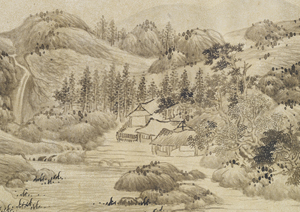Essay
In this handsome large-scale landscape, Lan Meng depicts a steep mountainside divided by a waterfall of multiple streams. Roiling rock forms predominate, dramatically surrounding the ravine into which the waterfall empties. The ravine, filled with the soft glow of light mist, separates foreground and background. In the upper left is an open pavilion around which monkeys cavort as bees buzz around them. Below a path descends to jutting rocks where there is a group of three figures: a seated elderly gentleman, his mouth open as if in conversation; his attendant standing and holding a staff with a small gourd attached; and most prominently, a seated man leaning his arm on the rock while gazing contemplatively at the action below. The central figure overlooks the lower waterfall and a dense grove of rugged trees where monkeys, accompanied by bees, play in the lower right foreground. At the bottom of the scroll, next to the artist's seals and inscription in the lower left, a single monkey hangs in mid-air, joyfully suspended from a vine. Red foliage clearly marks the season as autumn.
The combination of monkeys and bees is a rebus, a pun referring to serving in officialdom, as together the two Chinese characters for bees feng 蜂 and monkeys hou 猴, fenghou are a homophone for fenghou 封侯, or “appointed duke.” Since the artist's inscription does not indicate for whom the scroll was painted, if anyone specific, is this painting a general expression wishing the owner an auspicious appointment in officialdom or is it possible that the figures in the painting relate more directly to the meaning of the pun?
If we explore this latter line of reasoning, how do the figures relate to the phrase "appointed duke?" Does the central figure aspire to become an official? Is the elderly seated man announcing to the central figure his official appointment or trying to persuade or dissuade him from accepting a call to government service? Is the central figure a recluse committed to a solitary life in the mountains, as opposed to serving in officialdom? These are questions which remain unanswered.
In constructing this mountainous landscape, Lan Meng builds up mountains with turbulent rock aligned in curving ridges that carry the viewer’s eye back and forth across the picture plane, from the foreground trees in lower right to the distant mountain peaks in the upper left. Lan Meng uses this same zigzag compositional movement in other landscapes. Examples are found in paintings attributed to Lan Meng in the Katsuko and Teruko Suzuki Collection, Yuji Eda Collection, and a third in a private collection in Japan.
Lan Meng’s landscape in the Seattle Art Museum is notable for the artist's effective use of ink and light colored washes to describe the dynamic rock formations, suggest rising mist, and give the entire landscape a luminous glow. Soft pink washes complement the pale watery grey ink, while wet, dark strokes highlight trees and rocks. Throughout, the brushwork is natural and relaxed, the ink wet and moist. Unconcerned with pictorial exactness, two monkeys—comparable in size to those in the middle ground and foreground—swing from a dark branch on a distant peak. Unconcerned with clear spatial divisions, Lan Meng embeds in this towering landscape an intriguing pun.
In considering other Lan Meng paintings, he works in a variety of styles and techniques. Several of his landscape paintings are dry in comparison to the Seattle work. For example, in his painting Leaves Falling at Bi Pavilion, the ink is dark and dry, and the composition suggests a valley surrounded by mountains on a clear day. Another painting by Lan Meng, Lofty Mt. Lu in the Style of Gao Kegong, like the Seattle landscape, is dominated by wet ink washes. In both Lan Meng works the mist obscures, leaving spatial divisions unresolved. In the Seattle Art Museum’s landscape, this effect is heightened by the dramatic twists and turns of the mountain rock.
© 2013 by the Seattle Art Museum
Questions for thought
Answers
| Add an answerAdd Answer:
overview
Lan Meng
Quick Facts about the Artist
Born in Qiantang 錢塘 (now Hangzhou杭州).
Son of Lan Ying 藍瑛 (1585–after 1666).
Active during the Shunzhi and Kangxi reigns (1644-1722) of the Qing dynasty.
Painted landscapes in the styles of Song and Yuan masters.
inscriptions and seals
essay
In this handsome large-scale landscape, Lan Meng depicts a steep mountainside divided by a waterfall of multiple streams. Roiling rock forms predominate, dramatically surrounding the ravine into which the waterfall empties.
